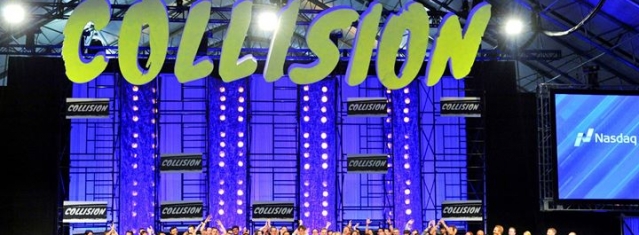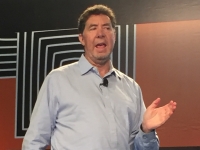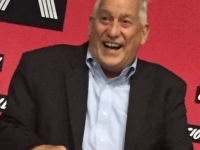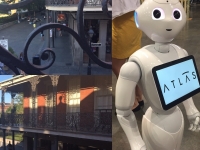Technology
INNOVATION AT THE INTERSECTION OF TECHNOLOGY, ART AND BUSINESS
COLLISION2017 DISRUPTS, CREATES, INVENTS

20,000 people from 119 countries, mostly millennials, along with a few stray baby boomers, Generation Xers & Zs came, met and connected last week at Collision2017 in New Orleans attempting to answer these and more questions. 13 standalone conferences with foci from marketing to design, coding to robotics, autotech to big data attracted 605 astonishing startups, many tech CEOs, investors and co-founders. 42.6 percent of attendees were women who participated in Collision´s “Women in Tech program“.
A good choice for Center Stage was the Coca Cola Company; a steady innovator at core, constantly reshaping the future of the organization and the panorama of startups. Captivating visionary Alan Boehme, Chief of Enterprise Architecture, Business Innovation and Emerging Technologies and his team, developed a fascinating program ensuring a better, faster job of bringing new technologies together, engaging startups and adopting state of the art innovations to blossom at Coca-Cola.
Known as “the Bridge“, the company developed a program, whereby well vetted, internally sponsored, startups are recruited and integrated, tasked to use state of the art technologies in solving burning problems and develop and redefine new themes. In return, startups are offered training, assistance with marketing, and the opportunity to participate in the program. This inspirational program with roots in Tel Aviv, has quickly expanded to other parts of the world including Boston, Los Angeles, Silicon Valley and beyond. “Where you have concentrations of capital, you tend to have hubs of innovation, especially technology. We have a long presence in Israel, but we had never really engaged in startups. So it was a good place to start and expand from there“ said Boehme.The rest was history. This successful program has grow to the speed of light and has attracted the attention of many other giants such as Turner, Mercedes Benz etc.who are now also participating.
Other examples of Coca-Cola´s innovations and leading edge strategy, includes drones making huge splashes, dropping off coke bottles from the skies to construction workers in Singapore and coke machines communicating with mobile devices. Lesser known, but equally important, are the company´s many world wide, sustainable projects, especially focused on water stewardship, quietly contributing to the wellbeing of millions and millions of people. Capitalizing on technology´s ability to create connections between people and systems, uniting the two, reducing costs through simplification continues to positions Coca-Cola at the pinnacle of the market. It´s still the “Real Thing“, thumbs up! Excellent program team Alan!
Wondering from stage to stage, passing Pepper, Atlas´ adorable humanoid, whose engaging “personality“ stole the show at Collision, one could not help but question if human work will soon become obsolete and replaced by robots. How are we adapting to such changes? How do people cope with disruption? How does innovation affect our workforce? Are we leaning towards isolation, away from collaboration?
Good news! “Human work will not be obsolete “says visionary Walter Isaacson, former CEO of the Aspen Institute, CEO of CNN, Managing Editor of TIME INC., author, now professor at Tulane University in New Orleans. “Instead, we have to embrace change. New technologies will call for different kind of jobs, different kind of skills and we will have to prepare our workforce for the future.“ As innovation and technological advances reshape our lives, they create opportunities for new sources of advancements and growth, affecting cultures, traditions, labor markets, and organizations. “Innovation is dependent on collaboration, it is a team sport. Great advances of our time such as the microchip, the computer, and the internet have arisen from collaboration. However, it is surprising that innovation has really somehow stagnated, slowed down lately, we need a next big breakthrough" said Isaacson.
So, is innovation moving to fast or too slow? What impact has connected mobility? Will we need drivers licenses in the future? Can a cyber-attack stop a driving car? Can a driverless car pick up our laundry?
Creative thinker Zack Hicks, CEO and President of Toyota Connected, focuses not only what you drive, optimizing the driving experience, but more importantly, he tries to understand what drives you. Toyota uses technology to seamlessly and efficiently align strategy and development of systems while re-inventing the way we think about mobility. Deriving from a foundation of predictive intelligence, coupled with a customer-centered approach, and solid research, Zack leads Toyota´s global efforts in developing anticipatory, mobile solutions that attract a wide variety of customers connecting autonomous cars to mobile devices, each other and to homes. Toyota's Mobility Services Platform, a global, cloud-based digital ecosystem which enable mobility services, allows car networks to share information on road conditions and traffic, services to manage fleets, expand ride-sharing capabilities. “It can leverage big data to contextually and intuitively improve services for our customers to deliver an amazing experience with our Toyota and Lexus brands" says Hicks. Such technological advances and innovative stance, allows Toyota to leapfrog many of its competitors and excite its customers once again, brining back the familiar commercial: “ Oh, what a feeling, Toyota!“
My take away: Innovation rests at the intersection of technology, art and business. Startups have to have high tolerance for risk, ability to stay focused and perseverance What would I add to Collision 2018? A Culture Stage.









